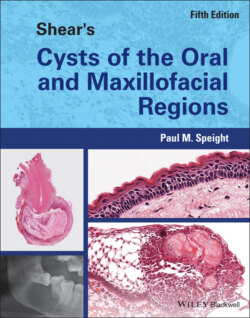Читать книгу Shear's Cysts of the Oral and Maxillofacial Regions - Paul M. Speight - Страница 57
Pocket Cyst (Bay Cyst)
ОглавлениеWith regard to the relationship between the tooth and the cyst lining, there is some evidence that there are two distinct histological types of radicular cyst. Brief mention has already been made of work by Simon (1980 ), who found that in some lesions a cavity may be present that is open to the root canal and is lined by epithelium that is attached to the root apex. Simon examined 35 extracted teeth with apical lesions still attached. Each specimen was decalcified and serial sectioned through the whole block. He found that the majority of lesions (27 cases: 75.2%) were periapical granulomas and that 8 (22.9%) of these contained strands of proliferating epithelium without evidence of cyst formation (e.g. see Figure 3.7). Only 6 cases (17.2%) were diagnosed as cysts. Three cysts showed an epithelial lining that was attached to the root apex, so that the root protruded into the cyst lumen, and the lumen was in direct continuity with the root canal, forming an open ‘pocket’ (Figure 3.18). Simon (1980 ) called these lesions bay cysts. The remaining cysts showed cavities entirely lined by epithelium with an inflamed fibrous wall, with no epithelial connection to the root apex. These were regarded as true cysts. Simon's data also suggest that cysts only comprise about 17% of periapical lesions and that bay cysts and true cysts have an equal frequency. This has been confirmed in a number of more recent studies that have shown that pocket cysts comprise about 50% of all periapical cysts. The actual frequencies reported have been 50.0% (Simon 1980 ), 38.5% (Nair et al. 1996 ), 56.3% (Ricucci et al. 2006b ), and 52.2% (Ricucci et al. 2020 ).
Figure 3.18 A low‐power view of a pocket cyst. The cyst lining is attached to the apex of the tooth (inset). Although in this plane of section the apical foramen is not visible, it can be seen that the tooth apex protrudes into the cyst lumen.
In the largest study, Nair et al. (1996 ) undertook meticulous serial sectioning of 256 periapical lesions and found that only 39 (15%) were radicular cysts. They also confirmed Simon's observations and showed that of the 39 cysts, 24 (61.5%) were true cysts and 15 (38.5%) were pocket cysts. In further detailed examination of these lesions, Nair (1998 , 2003 ) showed that in pocket cysts the epithelium was attached at the root apex, so that the lumen formed an extension of the root canal, and the intact epithelium acted as a barrier to seal off the contents of the infected root canal from the adjacent tissues (Figure 3.18). The cyst grows through accumulation of debris and necrotic tissue in the thus‐formed ‘bay’ or ‘pocket’. Simon (1980 ) and Nair (1998 , 2003 ) attached considerable clinical significance to the distinction of the two cyst types and suggested that pocket cysts were likely to heal after tooth extraction or endodontic treatment, whereas a true cyst may be self‐sustaining and can persist after treatment. From his data, Nair (1998 ) suggested that apical true cysts only account for about 10% of all periapical lesions, and this may explain the frequency of about 10% of persistent periapical lesions after conventional root canal treatment, and the low prevalence of residual cysts. Ricucci and Bergonholtz (2004 ) consider that the pocket cyst may be problematic for the endodontist, because the cyst fluid may be under pressure and may continuously wet the root canal, making instrumentation and filling difficult.
